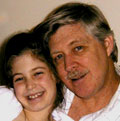
Bill Sheehan (pictured here with daughter Fiona) is network coordinator for the GrassRoots Recycling Network in Athens, Ga.
Sunday, 19 Mar 2000
ATHENS, Ga.
Woken up at 6:30 a.m. by my bouncy nine-year-old daughter, Fiona, who had been woken by her kitten. Sky gray, temperature cool — more like late winter than any weather in many weeks.
French toast, strong coffee (my wife calls it “cup-optional”). We read the Sunday paper while Fiona reads Harry Potter for the fourth time.
Sit with my wife picking out native plants from a seed catalog to plant in the yard of the new house we built in a community outside of Athens. We debate what is native — Clarke County? The Piedmont? Georgia? The Southeast? I decide to look up native plants that smell good, because I love to pinch off leaves, crush and smell them.
I savor the good family time, knowing that I will be taking three trips in the next two weeks.
The first trip starts tonight, when I’ll fly from Atlanta to Fort Walton, Fla., for a small meeting of national and regional forest activist groups gathering to strategize about campaigns to apply market pressure to save forests.
The GrassRoots Recycling Network takes a big-picture view of recycling. Our central message is zero waste — policies and practices that seek to emulate nature, where one organism’s waste is a resource for another organism. We are concerned about paper and wood waste because it comprises almost half of what goes into landfills. How can you save forests in the long run without stopping the flow of forest products into landfills?
In the afternoon, Chris, our projects coordinator, arrives. We go downstairs to work on faxing and emailing out a media advisory about a new report we plan to release next week. I rely on Chris to navigate the cyber-maze of computers, databases, programs, and other technological paraphernalia we depend on. GRRN is a national grassroots network that relies heavily on email, our listserve, and our website for communication, allowing us to work out of home offices like mine.
The report is called “Wasting and Recycling in the United States 2000,” a 64-page tome written by the Washington, D.C.-based Insitiute for Local Self-Reliance. It is the first comprehensive look in a decade at recycling in relation to wasting, and we’re going to release the report in five cities. I’ll be going to Los Angeles and San Francisco next Sunday for press conferences.
Chris gets the fax server set up while I fine-tune the advisory over the phone with Lance, our media wizard in the Washington, D.C., area. We decide to delay the advisory until tomorrow to get some more details on the speakers — a mayor in California and a Congressperson in D.C. Lance emails me a version of the advisory for our activists and I email it to 64 people who have expressed interest in releasing the report locally in towns and cities across the country.
I eat dinner with my wife and daughter, throw some clothes into my suitcase, and drive the hour and a half to the Atlanta airport in a steady rain, wondering when I will have time to type out this diary entry. Half an hour from the airport, I catch a weather report on the radio — a weather front is moving into Atlanta.
At the airport I rendezvous with two other people heading for the same meeting. The storm front hits. Our flight was scheduled to leave at 10:55 p.m. It is now 2:00 a.m. The rain has stopped. There is still no plane. But my laptop is humming, and I have finished today’s entry.
Monday, 20 Mar 2000
FORT WALTON, Fla.
Today started as an endurance test. We arrived via taxi from the Fort Walton airport at the rental beach house at 4 a.m. No empty beds, no instructions, so two of us slept on the living room floor. For two hours, that is, until the breakfast-makers appeared and began to work. Oh, this takes me back a long time — to my college days!
During the day we meet and talk in a group of 20, as well as in smaller groups. We talk about strategies to save wild forests by mounting market campaigns, that is, grassroots activist campaigns targeting corporations that buy or sell forest products unsustainably.
The passion and commitment of the participants are palpable. This is what keeps me going in this work. I feel honored to be among this youthful group of young adults and young-at-heart adults.
As a biologist (I have a PhD in ecology), I believe that our planet’s life support systems are in danger, and fundamental changes are needed to achieve a sustainable materials economy — or any other kind of sustainability. Grassroots, bottom-up activism is needed to challenge the status quo and effect the kinds of fundamental changes that are needed.
Why is a recycling group at a meeting of forest activists? We are seeking ways to link our zero-waste vision and America’s passion for recycling with campaigns to protect wild places. Ultimately, I think, that is why I recycle at home and spend most of my waking hours doing this work — to save the cathedral-like forests and other wild lands that have inspired me.
Two-thirds of all U.S. forest products (paper and wood) are thrown out every year, making up almost half the trash we send to landfills and incinerators. For my money, trying to save forests without dealing with the wasting treadmill — the linear path from forest to landfill — is a shell game. Landfills and incinerators function to remove resources from the economy so that new resources can be harvested to replace them.
It is the same shell game I played while fighting landfills in South Georgia in the early 1990s. Hit with a barrage of proposals for megadumps for out-of-state waste, we were fabulously successful in defeating them. But several years later, our nation’s rate of wasting resources continues to increase. We just push the waste elsewhere. Some forests are saved while overall tree cutting increases elsewhere. These trends are not sustainable.
It is not easy to convince forest activists engaged in campaigns to stop old-growth logging to take recycling seriously as part of the solution. But this group is receptive and eager to integrate recycling and zero waste demands into their forest campaigns.
In the evening, we all go out to a Thai restaurant and enjoy beer and camaraderie. Afterwards, the party moves on and I retreat for a good night’s sleep.
Tuesday, 21 Mar 2000
DESTIN, Fla.
I wake up at first light, rested. The full moon is setting as the sun rises in a clear sky. From the third floor balcony of the rental house, a sea of rooftops gathers like tide pool critters between me and the ocean.
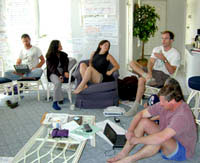
Casual meeting, big agenda.
I call Chris at the office to catch up on happenings from the day before. We are making final preparations for releasing a new report next week on the state of wasting and recycling in the United States. Lots of loose ends remain for press conferences in Los Angeles, Washington, D.C., and San Francisco, and for paper releases by activists in other cities. We discuss the most urgent needs. My to-do list doubles.
The forest meeting convenes again for the second and final day. The blinds are pulled all the way up to let in the bright sunlight. The walls gradually fill up with oversized flip chart sheets covered with bright magic marker scrawlings. The participating organizations all have somewhat different perspectives, circumstances, and goals relative to forest protection. Our agile facilitator skillfully guides us to areas of agree
ment.
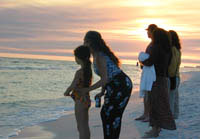
Porpoise watching.
A discussion hits close to home on the merits of selecting campaign targets based on ecological imperatives, on what nature needs. Mike draws a diagram on the flip chart of the world, trees, a building (signifying forest products), and a person. I add a toilet at the bottom, signifying the wasting of two-thirds of paper fiber and a vast amount of lumber, making more cutting necessary. Someone suggests marches from clear-cut forests to landfills to raise public awareness. Jake throws out a slogan: “Stumps to Dumps!” It clicks.
After a hearty meal of basmati rice, sushi, and apple cobbler with tofu-sesame sauce, we relax on the beach and watch porpoises swim along shore as the sun sets. An energizing day.
Wednesday, 22 Mar 2000
ATHENS, Ga.
I am up at 4:30 a.m. to catch a plane back to Atlanta, then drive to Athens in the bright spring air washed by Sunday’s rains. At the house, I check in with Chris, take a shower, and relax a bit before diving into the pile of accumulated tasks.
Contemplating the awaiting workload, I gaze out of the window of my office. The weather is unusually perfect today. To the south, the main floor and porch rise part way up the boles of stately white oaks, making our new house feel like a tree house. The red oak that grows among them has been flowering for almost two weeks, while the white oaks haven’t broken bud yet. Behind the oaks, the new leaves of a tulip poplar are vibrant pale green against the cloudless sky.
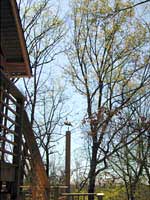
Room with a view.
The south side of our house faces a slope of recovering woods. Aerial photos from the late 1930s and the 1940s show that these woods and our house stand on what used to be a cotton farm. Arsenic used for controlling insects probably still lingers in the red clay subsoil. The rich topsoil is long gone — our house probably sits several feet lower that it would have 100 years ago. Although they are “second growth,” our woods are starting to heal.
Jennie (my wife) comes home for a lunch of ramen noodles on the deck. After we greet, she points to a sheet of paper on the counter and says, “Wait ’till you read this!” It is a letter from our daughter’s chorus teacher and, reading the first line, I know why she is riled. The letter exudes about the generous donation of new T-shirts that 900 students will wear at an upcoming, district-wide public school concert. The donor is Pepsi-Cola. We make a few quick calls to school administrators and confirm the obvious: The shirts will bear the logo of the liquid candy maker.
Commercialism in public institutions is a pet peeve of ours. My wife’s concern stems from her work in a lab at the university where research is increasingly funded by corporations. My interest comes from the GrassRoots Recycling Network’s three-year campaign to get the Coca-Cola Company to take responsibility for its plastic container waste. In the course of the campaign, I have learned that Coke and Pepsi are in a race to sign contracts with public schools that offer money in exchange for exclusive vending rights. Like the tobacco companies, the soda companies have come to realize that brand loyalty is established early.
I can tell that my wife is ready to do battle on this one, and I feel excited about working together on this. It has been eight years since we last teamed up, to get a hazardous waste dump cleaned up. It was a football-field-sized pile of toxic steel mill “flue dust” sitting next to an elementary school in a poor African-American neighborhood in South Georgia (near where we lived at the time). It took three years but we won and it had a lot to do with launching my current career.
After lunch I descend again to the office. Chris works with Amanda, a part-time student helper from the university, to mail out our new reports — Wasting and Recycling in the United States 2000.
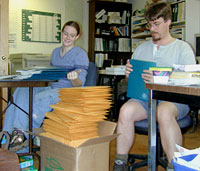
Amanda and Chris going postal.
I settle down to tackle the backlog. GRRN has grown rapidly since our formal launch three years ago. We formed to revitalize the recycling movement and to counter attacks by presenting a new vision — zero waste. The report, which we are releasing next week in four cities, is part of a growing set of resources we are developing to articulate the zero waste vision. I call Marty Matsch, who works at Eco-Cycle, a community recycling organization in Boulder and one of our most active supporters. She is editing a video on zero waste made last summer by Paul Connett, a chemist who helps grassroots groups fight incinerators. I am delighted to learn that she is almost finished reworking it to fit the 28-minute cable TV format.
I return a message concerning another piece of our zero waste literature — a press briefing kit being developed by the San Francisco-based Public Media Center, a seasoned public relations firm that produced the op-ed page ads we ran in the New York Times last summer. Those ads made Coke finally take notice of us. I had hoped to have the briefing kits finished by the time we released the Wasting report but, alas, it is not meant to be.
My daughter comes home from school and we have a big reunion. I learned that she cried after I drove off in the rain Sunday evening because it was dark and rainy. I take her to her weekly guitar lesson in town.
In the evening, we have dinner and family time. I put the family to bed then do some more work in a peaceful office without phones ringing. Having a home office is both a boon and a danger because it is so convenient.
Thursday, 23 Mar 2000
ATHENS, Ga.
The weather is beautiful again. I am torn between work and wanting to go see if the big water snake is still sunning itself in the same spot it has been three times in the past month beside the creek down near the river. I decide to save that walk for the weekend.
I spend most of the day in the office. I deal with fundraising matters. As chief cook and bottlewasher for GRRN, I am responsible for raising money as well as spending it. We have recently hired a fundraising consultant. That has taken a load off my mind, but means I actually spend more time on it.
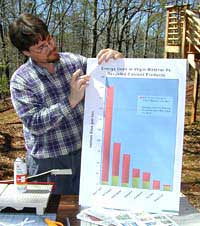
Chris gets crafty.
Chris is working on getting graphics ready for the press events. The graphics are color blow-ups of graphs from the Wasting report. By printing from our color printer, then cutting and pasting, Chris has found a way to make them for a fraction of the price we originally thought we would have to pay.
At lunch, I call some parents in the community about child care next week when Fiona will be on spring break and I will be away. About four years ago, we heard of a group here in town trying to establish an intentional community. The concept was to have both individually owned lots as well as jointly owned commons. Like many folks, we were tired of traditional, faceless neighborhoods, and found the idea of a sort of extended family intriguing. We bought a lot and finished building our house this past fall. And it’s been great — we love the community.
Translating great ideas into reality is not easy. As the resident recycling expert, it didn’t take much persuasion to get me to design and set up a reuse/swap center in one of the old farm buildings. Dubbed the “Free Store”
by the kids, it was a series of shelves where folks were encouraged to trade still serviceable household items. As I sawed and nailed, I had wonderful visions of Kenney Ridge becoming a Zero Waste community. I stood back and surveyed my handiwork, confident that the sound economic theory underlying it, coupled with an unusually motivated group of residents, would result in a model recycling system. It’s a funny thing, theory versus reality — one year later even I had to admit that it was largely a bust.
Back in the office: We have lots of details still to tie up for the press events early next week. I exchange multiple calls, faxes, and emails throughout the day with Rick Best, our president in Sacramento, and Lance King, our media man in Washington, D.C., about the report release. In one phone message I learn that Mayor Willie Brown is confirmed for the San Francisco press event, in another that Rep. Sam Farr is confirmed for D.C. Things are hopping! I finalize lodging arrangements in L.A. and San Francisco for my three-day trip next week.

Chris shows me the animated logo he has been working on for a “Greenwashing Alert” we will post on our website, in response to a “consumer advisory” about our campaign that Coke posted on its website.
After dinner, I hang out with the family, watching part of a video, before we all turn in.


